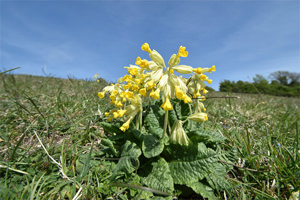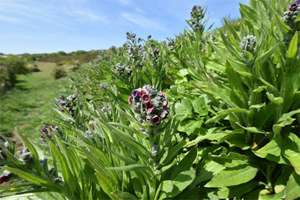The vault of heaven was almost discernible from under the skies above Newtimber Hill in Sussex yesterday. It is six weeks into a ‘lockdown’ trying to stem the advance of the coronavirus pandemic and it was our first venture by car anywhere in that time. Grief lies heavy on the land. Gratitude to front-line workers is palpable. We sought therapy on the South Downs. This post is for those who aren’t able to do the same.
For nature lovers there were consolations of lockdown: less traffic noise and skies that weren’t criss-crossed by contrails. A south-westerly wind kept traffic noise from the A27 to a minimum. One could have been on Newtimber 30 years ago. The trilling of skylarks could be heard well enough to locate them up above us. We kept an eye on them and traced their descent as they went silent and landed on their nest sites in the short downland grass. The calls of redstart, thrush, chiff-chaff, buzzard and jackdaw punctuated the air. Bees buzzed and bumped into the solid world. Brimstones bounced on the gentle breeze.
And today, under the same blue skies, it is the 75th anniversary of VE Day, marking the end of hostilities in Western Europe. Near to us is the Care for Veterans Centre (formerly The Queen Alexandra Hospital Home) for physically-disabled ex-service personnel. Just after lunch, Spitfire SM520 overflew the Centre several times, tipping its wings to salute the veterans down below. It was a moving sight and the growl of the Rolls Royce Merlin audible long before the first flash of sunlight off its wings was visible. Memories could not fail to have been stirred. Emotions within us non-combatant bystanders most certainly were. Brits have historically regarded the Spitfire as a liberator of the skies. Many Europeans may also feel the same. The mere sight of one makes us misty-eyed.

Derek

I never knew our half-brother Derek Arthur Grose Tomlinson. He didn’t make it to see active service in the war because as a temporary Sub-Lieutenant in 766 squadron, the Royal Naval Volunteer Reserve, he died whilst training. His Swordfish NF 337 crashed on November 17th 1944 at Inskip in Lancashire. With him was Acting Petty Officer Airman Peter Horatio Nelson. Both were only 20 years old. Had they survived the war and lived to mark VE Day’s 75th anniversary, they would have been 95.
With the millions of others, service personnel and civilians alike, who lost their lives in the war that we remember today, the skies above them - and through which many of them flew - are the same skies that we look up and see today. They may contain less birds or more jets or less warplanes or more carbon pollution than was the case in the 1940s, but their potential to frighten us or give us solace remains the same.
It’s an ideal moment to remind ourselves that VE means Victory in Europe, not Victory over Europe. The victory was over the storm clouds of populism, nationalism and fascism, not Europe per se. Cloudless skies over England’s South Downs. Nature therapy. Honouring those who gave so much then and do so today against an invisible virus.







